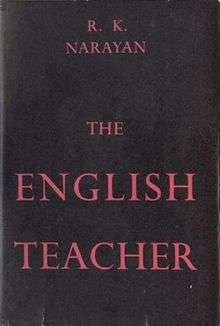The English Teacher
The English Teacher is a 1945 novel written by R. K. Narayan. It is a part of a series of novels and collections of short stories set in "Malgudi". The English Teacher was preceded by Swami and Friends (1935), The Bachelor of Arts (1937) and Malgudi Days (1943) and followed by Mr. Sampath – The Printer of Malgudi.
 First edition of the novel The English Teacher by R. K. Narayan | |
| Author | R. K. Narayan |
|---|---|
| Country | India |
| Language | English |
| Genre | autobiographical novel |
| Published | 1945 Eyre & Spottiswoode |
| Media type | |
| Pages | 184 |
| OCLC | 6305085 |
| 823 | |
| LC Class | PR9499.3.N3 E5 1980 |
| Preceded by | The Bachelor of Arts and Malgudi Days |
| Followed by | Mr. Sampath – The Printer of Malgudi |
This novel, dedicated to Narayan's wife Rajam is not only autobiographical but also poignant in its intensity of feeling. The story is a series of experiences in the life of Krishna, an English teacher, and his quest for inner peace and self-development.[1]
Plot summary
As an English teacher and lecturer at Albert Mission College, Krishna has led a mundane and monotonous lifestyle comparable to that of a cow. He too plays an important role of protecting the Indian culture. Soon his life took a turn when his wife, Susila, and their child, Leela, come to live with him. With their welfare on his hands, Krishna learns to be a proper husband and learns how to accept the responsibility of taking care of his family. He felt that his life had comparatively improved, as he understood that there's more meaning to life than to just teaching in the college. However, on the day when they went in search of a new house, Susila contracts typhoid after visiting a dirty lavatory, keeping her in bed for weeks. Throughout the entire course of her illness, Krishna constantly tries to keep an optimistic view about Susila's illness, keeping his hopes up by thinking that her illness would soon be cured. However, Susila eventually succumbs and passes away. Krishna, destroyed by her loss, has suicidal thoughts but gives them up for the sake of his daughter, Leela. He leads his life as a lost and miserable person after her death, but after he receives a letter from a stranger who indicates that Susila has been in contact with him and that she wants to communicate with Krishna, he becomes more collected and cheerful. This leads to Krishna’s journey in search of enlightenment, with the stranger acting as a medium to Susila in the spiritual world. Leela, on the other hand, goes to a preschool where Krishna gets to meet the headmaster, a profound man who cared for the students in his school and teaches them moral values through his own methods. The Headmaster puts his students as his top priority but he doesn’t care for his own family and children, eventually leaving them on the day predicted by an astrologer as to be when he was going to die, which did not come true. Krishna gets to learn through the headmaster on the journey to enlightenment; eventually learning to communicate to Susila on his own, thus concluding the entire story itself, with the quote that he felt 'a moment of rare immutable joy'.
Literary significance and criticism
The synopsis at the back of 'The English Teacher' by Indian Thought Publications says, "Never has the magical storyteller of imaginary Malgudi woven tragedy and humour so deftly together."
Book information
A paperback edition was issued in Chicago by the University of Chicago Press in 1980 with ISBN 0-226-56835-0. Many other editions have been issued in other countries by several other publishers. It was published in the U.S. as Grateful to Life and Death in 1953 by The Michigan State College Press.
References
- Fernando, Iranga (6 October 2002). "The English Teacher". Colonial and Postcolonial Literary Dialogues (Western Michigan University). Retrieved 6 March 2019.